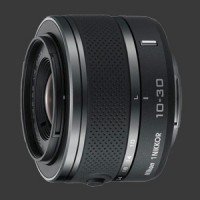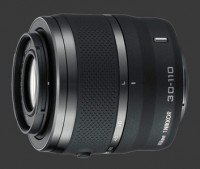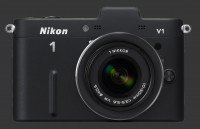Nikon 1 V1 Review
Nikon 1 V1 Usability - How easy is it to use?
Nikon took the chance to reinvent things with the introduction of their V1 and J1
Nikon 1 J1 SLDs and the result is reviewed here. Overall, the new interface is reasonably simple and easy to learn but it has its share of oddities. Keep in mind that future Nikon 1 cameras may operate quite differently, operating around the newly defined mount and sensor-size.

The camera body is rectangular with a substantial feel to it. To the rear, the EVF protrudes for added comfort and, to the front, a small vertical line serves as grip. The front of the camera is mostly smooth and the rear has a small rubberized area. While better than nothing, the V1 never feels secure without two hands holding it. A neck-strap is provided with the camera.
The camera feels very solid and even the combined battery and memory card compartment door is top-notch. The EVF frame is rubberized for extra comfort. It compared in size to a large compact or a medium-sized SLD. Given the placement of the sensor halfway through the thickness of the body, there is room to make Nikon 1 cameras a lot smaller.
Supporting the camera from the lens, the V1 has a good weight but does not feel heavy at all. Since zooming is done mechanically for both the 10-30mm F/3.5-5.6
Nikkor 1 10-30mm F/3.5-5.6 VR and 30-110mm F/3.8-5.6
Nikkor 1 30-110mm F/3.8-5.6 VR lens, this is the natural thing to do. These lenses both have a collapsible design originally pioneered by Olympus. To expand the lens, press the round button on its barrel and twist. Neatly, this camera automatically turns on when the lens passes the unlocked position.

The top plate is somewhat bare with a flat power button, a flat shutter-release and a video-record button. Also visible from the top is the EVF bump and accessory port cover. Regardless of the mode, the shutter-release captures and image and the video-record button starts and stops video capture. As described in the previous page of this review, image and video framing always match the preview.
The shutter-release is a standard two-stage release with short travel and a very soft halfway point. Luckily, it does not release if focus has not been acquired in AF-S mode. Placement could be better though as it is a little from from the side of the camera. The shutter-release is only slightly higher than the video-record button, so confusing the two is unfortunately possible.
 Remaining controls are all found on the back of the V1. Some of these are unique to the V1 and its near-twin, the J1, so more explaining than usual is required. There is a rubberized area to rest the thumb between these controls and the rear LCD. Right next to it is an unusual mode-dial with four positions:
Remaining controls are all found on the back of the V1. Some of these are unique to the V1 and its near-twin, the J1, so more explaining than usual is required. There is a rubberized area to rest the thumb between these controls and the rear LCD. Right next to it is an unusual mode-dial with four positions:
- Standard Image mode is marked by a green camera icon. This lets the V1 operate similarly to advanced compact cameras. An option in the menu lets the V1 operate in Program, Shutter-Priority, Aperture-Priority, Manual or Automatic Scene Selection mode. The camera is set to 3:2 aspect ratio for both images and video.
- Video mode is marked by the silhouette of a classic film camera. This lets the V1 shoot both video and images with a 16:9 aspect ratio in any PASM mode with the obvious limitation that the shutter-speed cannot be set below the frame-rate.
- Smart Photo Selector is an extension of Nikon's own BSS seen on some Coolpix cameras. This takes advantage of the extremely fast burst rates of the CMOS sensor to buffer a series of images starting when the shutter-release is pressed half-way. On the full-press, the camera saves the 5 best images for sharpness and composition. It presents the best image according to its metric as the final result.
- Motion Snapshot takes a 16:9 aspect-ratio shot along with a one second slow motion video of the scene which preceded the shot. It also adds one of four sound-tracks while playing the whole thing back. This is a rather gimmicky trick which we would rather see replaced by traditional exposure-modes.
The mode-dial is vertically mounted with textured sides to make it easy to change. Indeed it is, perhaps even too easy despite the detents, since it frequently unintentionally moved from its last position.
Depending on the mode-dial's position, the F button near the top of the camera takes on different functions. In Standard Image mode, it selects between Mechanical, Electronic and High-Speed Electronic shutters. This last mode forces the camera in Auto mode, including Auto ISO with a 3200 limit. It feels like this is the wrong control for the user since there is no easily understood connection between a type of shutter and photographic results. With High-Speed Electronic, a menu option appears to chose between 60, 30 or 10 FPS continuous drive.
In Video mode - which we grateful to see on any camera - the F button chooses between HD and Slow-Motion. The exact video mode is then chosen via the menu. In HD mode, options are 1080i @ 60 FPS, 1080p @ 30 FPS or 720p @ 60 FPS. In Slow-Motion mode, choices are 400 or 1200 FPS. The F button does nothing in Smart Photo Selector mode and chooses the background music in Motion Snapshot.
Right next to the F button is a vertical rocker. This one is labeled with the zoom-in and zoom-out symbols which is what it does in Playback mode. In image and video modes, it controls the primary exposure parameter or Program-Shift in P mode. In Manual mode, it controls the shutter-speed while a thin control-dial around the 4-way controller adjusts aperture.

The 4-way controller is surrounded by a control-dial and 4 buttons. These four buttons have traditional functions: Display changes the display mode, Playback enters Playback mode, Delete deletes images and Menu enters the menu system. Additionally, each direction on the 4-way controller is assigned a function:
- Up is AE-L/AL. This is configurable to lock exposure, focus or both. Since this button must be held while recomposing or waiting for action, its placement is uncomfortably low.
- Right is for EC which is then adjusted ±3 EVs in 1/3 increments with the control-dial. Unfortunately setting EC is done blind since the display does not update until after the adjusted is accepted by pressing OK or the right direction again.
- Down is for AF with choices of AF-S, AF-C, MF and AF-A. Since Nikon 1 lenses lack a focus ring, manual focus is performed using the rear dial. The granularity of MF-steps is fine and the resolution of the display is sufficient to distinguish between each step.
- Left is for the Self-Timer. There are six options: Off, 10s, 5s, 2, 2s Delayed-Remote and Instant-Remote. Self-timers annoyingly reset themselves after each shot, making tripod shooting with a remote inefficient.
The control-dial spins freely, making it easy to change accidentally. As it stands, in most situations, it does not do anything so this is not much of a problem except in Manual mode.
The Nikon 1 V1 has a high-resolution 0.47" EVF with 1.4 megapixels. It provides 100% coverage and simulation of white-balance setting. The view is bright, crisp and very detailed. Refresh is fluid and it keeps up with action rather well, particularly when using the continuous drive. Truly, using the EVF is one of the things that makes using the V1 quite pleasant. Shooting at eye-level provides greater stability, makes it easy to frame precisely and avoids glare in bright light. There is also an excellent Eye-Start sensor which is hard to live without once you get used to it.

The 3" LCD is great too and plenty sharp with 920K pixels. The view is clear and sharp with good visibility in bright light. Motion is fluid there too. The LCD also keeps up with action well and shows 100% coverage. The display button cycles a few options, including a grid view. Notably absent is a Live-Histogram. A luminance histogram is available on review though. Sadly, neither EVF nor LCD is exposure-priority.
The bottom of the camera features a metal tripod, inline with the optical center of the camera, plus a combined battery and memory compartment door. The door hides a standard SDXC and a large battery.
 |
Please Support Neocamera
All information on Neocamera is provided free of charge yet running this website is a huge endeavor. Purchases made via affiliate links found throughout the site help keep it running and up-to-date. There is no additional cost to you, so please consider buying via these links to our affilates:
If you found any information on this site valuable and did not purchase via our affiliate links, please considering donating via PayPal:
Any amount will be greatly appreaciated. Thank you for your support!
Nikon V1 Highlights

Sensor-Size: 13 x 9mm

Actual size when viewed at 100 DPI
| 10 Megapixels Mirrorless | ISO 100-6400 |
| Nikon 1 Mount 2.7X FLM | Shutter 1/16000-30s |
| 0.47" Built-in EVF 1.4 Megapixels | Full manual controls, including Manual Focus |
| Automatic Eye-Start sensor | Custom white-balance |
| Built-in Dust Reduction | Spot-Metering |
| 60 FPS Drive, 60 Images | Hot-Shoe |
| 1920x1080 @ 30 FPS Video Recording | Stereo audio input |
| 3" LCD 920K Pixels | Lithium-Ion Battery |
| Secure Digital Extended Capacity |
Updates
2025.01.18

Fujifilm GFX 2025 Lens Roundup
Lens Review roundup of Fujifilm GFX Medium-Format lenses. Quality, performance and handling of the GF20-35mm F/4R WR, GF30mm F/3.5 Tilt-Shift and the GF55mm F/1.7.
2024.11.18

Best 2024 Photography Gifts for Every Budget
Great gifts for photographers and photo enthusiasts selected for every budget among the best products of 2024.
2024.08.07

Eye Protection Tips for Professional Photographers
The four main considerations for professional photographers regarding eyewear.
2024.07.14

Fujifilm X100VI Review
Flagship fixed-lens compact digital camera with a 40 MP sensor and Image-Stabilization, a first for the series. Retro design featuring dual control-dials, plus direct ISO, Shutter-Speed and EC dials. Its hybrid viewfinder can switch between EVF and OVF mode.
2024.05.09

Fujifilm GFX100 II Review
Flagship 102 Megapixels Medium-Format Mirrorless Digital Camera with 8-Stop 5-Axis IBIS, 8 FPS Drive, 8K Video and 400 MP Super-Resolution capture in a weatherproof and freezeproof body with dual control-dials and dual memory-card slots.
2024.04.03

Fujifilm X-T5 Review
Newest Fujifilm flagship boasting a 40 MP APS-C sensor, 5-axis IBIS with 7-stop efficiency, 15 FPS continuous drive, 6.2K Video capture, dual control-dials and dual SDXC UHS-II slots in a sturdy weatherproof and freezeproof body.
2023.11.20

Best Digital Cameras of 2023
Find out which are the Best Digital Cameras of 2023. All the new Mirrorless Digital Cameras from entry-level to high-end professional.
2023.07.10

Fujifilm X-H2 Review
40 Megapixels APS-C Hybrid Mirrorless Digital Camera with 7-stop IBIS. Fastest shutter ever and 8K video capture. Large builtin EVF with 0.8X magnification and 5.8 MP, plus an Eye-Start Sensor. Packed with features and large number of controls in a weatherproof and freezeproof body.
2023.05.07

Sony FE 20-70mm F/4G Review
Review of the unique Sony FE 20-70mm F/4G lens. The optical zoom of this lens spans ultra-wide-angle and medium focal-length coverage, making it one of the most versatile Full-Frame lenses on the market.
2023.01.15

Huion Inspiroy Dial 2 Review
Review of the Huion Inspiroy Dial 2 tablet, a medium sized drawing surface with dual dials and customizable buttons. Connects via USB-C or Bluetooth 5.0 with Windows, Linux and Android support.
2022.12.08

How to Pack for a Photo Trip
Find out how to pack for a travel photography trip, carry your gear safely while meeting airline regulations.
2022.11.13

Best Digital Cameras of 2022
The best digital cameras of 2022. A short list of the most outstanding models in their respective categories. Choose one for yourself or as a gift.












